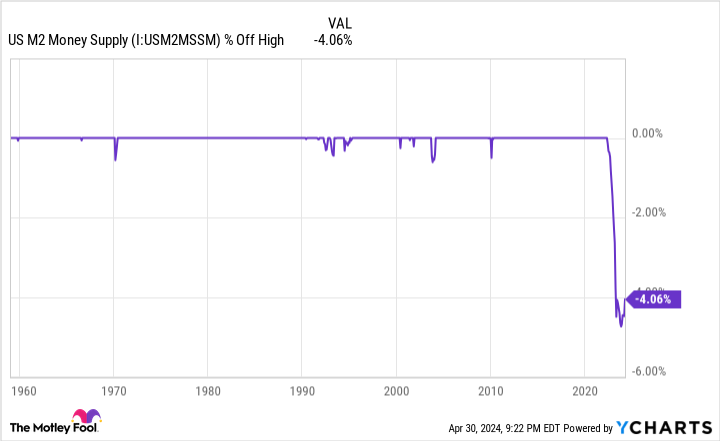
Over the past four years, Wall Street has been a breeding ground for volatility. In successive years, starting in 2020, the timeless Dow Jones Industrial Average (DJINDICES: ^DJI)widely supported S&P500 (SNPINDEX: ^GSPC)and growth equity driven Nasdaq Composite (NASDAQINDEX: ^IXIC) have bear and bull markets.
While the stock market has proven to be a wealth creator over the long term, it simply cannot predict with any concrete accuracy where the stock market will go in the coming days, weeks, or months. Nevertheless, this does not stop investors from predicting the future to gain an edge.


While nothing is set in stone in the short term, a select group of predictive indicators and money-based measures have a remarkable track record of predicting shifts in the U.S. economy and/or stock market.
One of these instruments, which appears to be a warning sign of a big move in stocks, is the US money supply.
No one has seen the US money supply do this in 90 years
Although there are five different measures of the money supply, the two of greatest importance are M1 and M2. The first takes into account all cash and coins in circulation, as well as demand deposits in a checking account. It is easily accessible capital that can be spent with the proverbial snap of a finger.
On the other hand, M2 uses everything in M1 and adds money market accounts, savings accounts, and certificates of deposit (CDs) under $100,000. We're still talking about capital that can be spent relatively easily, but there are some additional steps needed to achieve this. It is this measure, the M2 money supply, that is raising alarm bells for the US economy and Wall Street.
What's interesting about the attention the M2 money supply is attracting is that it's a measure that most economists often ignore. It has been rising steadily for decades that it is almost taken for granted that the money supply will increase as the US economy grows over time.
But on those very rare occasions in history where we have witnessed a meaningful decline in the money supply in M2, bad things for the US economy and stocks followed.
Based on data from the Federal Reserve Board of Governors, the M2 money supply peaked at $21.722 trillion in April 2022. As of March 2024, M2 was $20.841 trillion. While this looks like a fairly moderate decline of $881 billion (4.06%) over roughly two years, it represents the first decline in the M2 money supply of at least 2% since the Great Depression.
Let me add some color and context to the data above. This overall decline of 4.06% comes after the U.S. money supply grew more than 26% year-over-year during the COVID-19 pandemic. Historically low interest rates and multiple rounds of fiscal stimulus injected capital directly into the US economy. It is possible that the decline we are now witnessing is simply a reversion to the mean after a historic expansion of M2.
Moreover, the money supply of M2 actually has increased by 0.46% year-on-year, after declining in 2023. The rising money supply is something we expect in a growing economy: more cash and coins are needed to complete an increasing number of transactions.
The caveat to the above is that history (so far) is unbeaten if the M2 money supply retreats by at least 2% from its all-time high.
WARNING: The money supply is officially shrinking. 📉
This has only happened four times in the last 150 years.
Each time, a depression followed with double-digit unemployment rates. 😬 pic.twitter.com/j3FE532oac
— Nick Gerli (@nickgerli1) March 8, 2023
In March 2023, Nick Gerli, CEO of Reventure Consulting, posted the chart you see above to During this period, more than 150. During a one-year period, he found only five cases in which the M2 returned by at least 2% on an annual basis: 1878, 1893, 1921, 1931-1933 and 2023.
During the four previous instances of meaningful declines in the M2, the US economy fell into a depression, with a corresponding unemployment rate reaching double digits.
To be fair, there was no central bank in 1878 or 1893. Furthermore, the Fed and the federal government today have a much better understanding of how to fight back against economic downturns than they did a century ago. This makes it very It is unlikely that a depression with double-digit unemployment will occur.
But the data doesn't lie – and history has never been wrong until now. With less cash and coins in circulation, consumers will be forced to reduce their discretionary spending. That is bad news for the economy. If a recession were to take shape, as the decline in M2 seems to imply, history suggests that a significant drop in stock prices could follow.


Perspective is a powerful tool on Wall Street
The great thing about history is that it is a two-sided coin. While there are obvious headwinds that could put a serious dent in the current bull market for the Dow Jones, S&P 500 and Nasdaq Composite, the outlook paints a much rosier picture for long-term investors.
Let's address the elephant in the room: recessions are normal And inevitable part of the economic cycle. As much as we would like them to disappear and never return, downturns in the American economy will occur from time to time.
However, historically, recessions are short-lived. Since the end of World War II, nine of the twelve U.S. recessions that took shape have resolved within twelve months. Meanwhile, none of the remaining three reached 18 months. Although recessions can be unnerving, they disappear quickly.
On the other hand, most of the growth periods that followed these twelve recessions lasted for several years. In fact, two periods of expansion lasted longer than ten years. More often than not, corporate America will benefit from these long-term expansions for the American economy.
Patience and perspective have worked wonders for investors, as shown in a dataset from the analysts at Bespoke Investment Group.
Researchers at Bespoke measured the length of every bear and bull market in the S&P 500 since the start of the Great Depression in September 1929. The 27 bear markets in the S&P 500 lasted an average of 286 calendar days, or about 9.5 months. By comparison, Bespoke found that the 27 bull markets in the S&P 500 lasted an average of 1,011 calendar days (as of June 2023), or about 3.5 times as long as the typical bear market.
Additionally, Bespoke data shows that 13 bull markets in the S&P 500 lasted longer than the longest bear market. This reinforces the idea that while bear markets and recessions can be scary in the short term, optimism and long-term thinking are a winning recipe on Wall Street.
Regardless of what the M2 money supply or other predictive indicators suggest will happen in the coming weeks or months, the history is crystal clear that the Dow Jones, S&P 500 and Nasdaq Composite will move higher in the long term, along with the US economy.
Don't miss this second chance at a potentially lucrative opportunity
Have you ever felt like you missed the boat on buying the most successful stocks? Then you would like to hear this.
On rare occasions, our expert team of analysts provides a “Double Down” Stocks recommendation for companies they think are about to pop. If you're worried that you've already missed your chance to invest, now is the best time to buy before it's too late. And the numbers speak for themselves:
-
Amazon: If you had invested $1,000 when we doubled in 2010, you would have $20,972!*
-
Apple: If you had invested $1,000 when we doubled in 2008, you would have $34,604!*
-
Netflix: If you had invested $1,000 when we doubled in 2004, you would have $312,433!*
We're currently issuing 'Double Down' warnings for three incredible companies, and another opportunity like this may not happen anytime soon.
*Stock Advisor returns April 30, 2024
Sean Williams has no position in any of the stocks mentioned. The Motley Fool has no position in any of the stocks mentioned. The Motley Fool has one disclosure policy.
The US money supply is doing something so rare it hasn't happened since the Great Depression – and a big move in stock prices could follow was originally published by The Motley Fool













